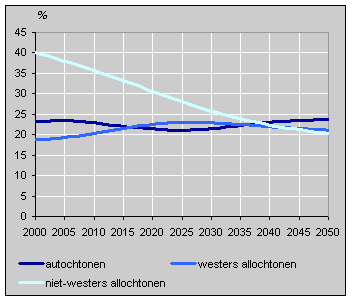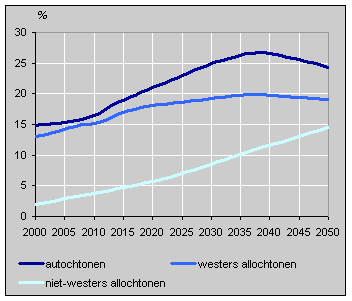Immigrants slow down ageing process

Non-western immigrants are a young population group in the Netherlands. At the moment 40% of them are younger than 20, nearly twice the proportion of western immigrants and natives. More than 80% of second generation immigrants are younger than twenty, compared with 15% of first generation immigrants.
However, the proportion of young people in the second generation is decreasing, as immigrant women are having fewer and fewer children on average. In addition the present second generation is growing older. But it will take a few decades before the percentage of young people among non-western immigrants is just as high as among western immigrants and the native population.
Immigrant and native population, 0-19 years

As non-western immigrants are still so young, the proportion of over 65s is very small: only 2% at the moment. This proportion will rise only slowly in the coming years, and will still be below 5% in 2010. The non-western immigrant group will only start ageing seriously in the very long term.
Western immigrants resemble the native population more as far as ageing is concerned. At the moment 13% of non-western immigrants are over 65, compared with 15% of the native Dutch population. These percentages will rise gradually in the coming years.
The forecast contains a noticeable kink for 2011, the year in which the post-war babyboom generation start reaching 65.
In the long run the proportion of over 65s among western immigrants will grow more slowly than among the native population. The explanation for this is that many western immigrants only stay in the Netherlands temporarily. Most of them return to their native countries after a longer or shorter period of work in the Netherlands.
Immigrant and native population, over 65s

The growth of the immigrant population will slow down the ageing process in the Netherlands. Without the immigrant population the percentage of over 65s would rise from 14% now to about 27% in the future. For the total population the increase is expected to be to 23%.
Maarten Alders